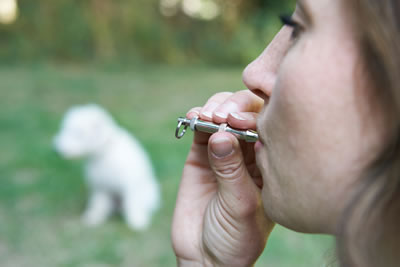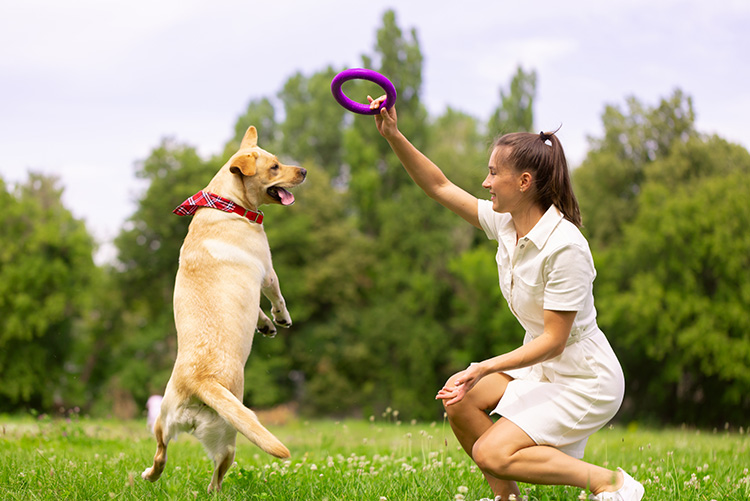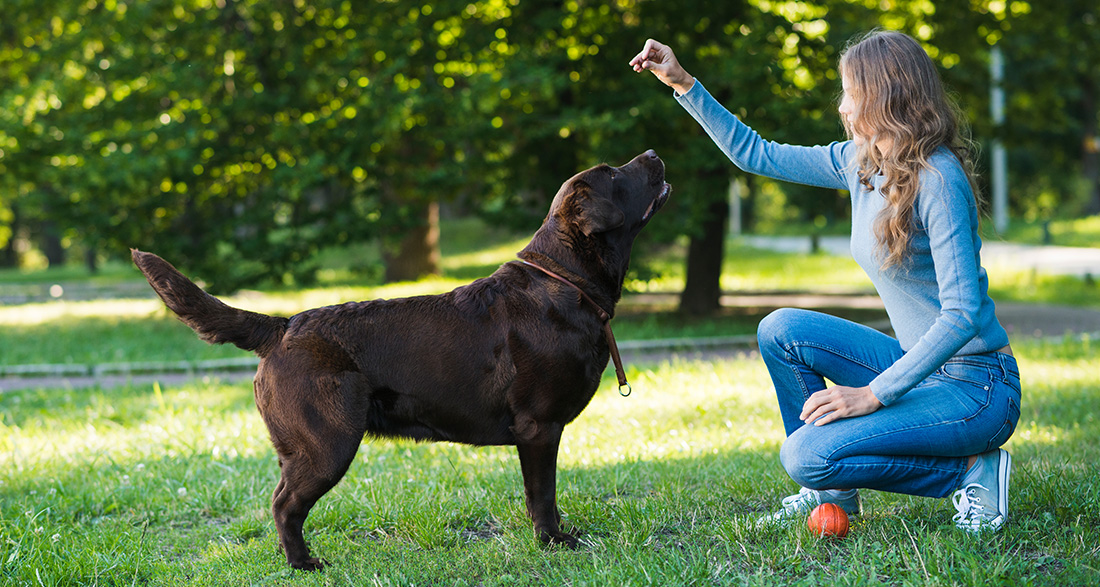At what age can I start dog training?
When the puppy moves into its new home, it’s advisable to give it a few days to get acquainted with its surroundings, life, and the dog owner. While formal dog training can commence around six months, the basics of education must be introduced to the puppy as early as possible. This includes teaching the young pup about compatibility and social behavior with other dogs, which it naturally learns when left among its littermates for a sufficient duration.
Social behavior is crucial, as the protective instincts towards puppies diminish after a short time, and small dogs need to learn how to interact with playmates and larger dogs. The puppy can only develop social behavior by allowing it to interact with other compatible dogs in a protected environment. Puppy training also involves familiarizing the little one with a puppy collar and leash early on.
While the puppy may not walk on a leash at this age, getting it accustomed to one as soon as possible helps avoid stress later on, especially considering leash laws in specific areas. Commence house training as soon as the puppy arrives home, although it is a gradual process. Numerous valuable suggestions on “Tips and Tricks” can be found on the internet.
What do you need for dog training?
Patience and perseverance are essential, especially if success in practice doesn’t happen immediately. The canine isn’t intentionally doing something wrong; it simply may not have grasped the problem correctly. In such cases, practice with the dog until it gets it right.
Valuable advice on this topic is readily available on the internet, and exchanging experiences with other dog owners can also be beneficial. However, it’s crucial never to train the dog for more than ten minutes consecutively to prevent overwhelming it and ensuring the training remains enjoyable.
Essential Accessories for Successful Training
Successful dog training requires suitable training materials. The following items may not all be necessary, depending on the training concept you choose for your pet:
Retrieval wood weighing between 150 grams and 2000 grams, depending on the dog’s size:
Retrieval and throwing sticks are indispensable for both training and group play. Avoid using random branches, as they pose a risk of injury to the canine.
Clicker in various designs for popular clicker training. Some clickers come with a brief guide, but there are also very affordable pocketbooks on clicker training.
Training discs for education using the signal tone method:
Tasty treats given only when the canine performs correctly. A well-dosed motivation in the form of a snack and lavish praise is always beneficial.
Buffalo horn whistle, whistle, and high-frequency whistles

High-frequency whistles facilitate quiet and effective communication between humans and animals. Depending on the dog whistle, individual pitch levels can be set. Since dogs primarily respond to acoustic signals and tones rather than human speech, this distinctive sound, standing out from other noises, should be reserved for the most important dog command—immediately coming to its owner’s side. Of course, other verbal cues agreed upon with the dog, such as “Here” or “Come,” can be used. Given that high-frequency whistles can be perceived over long distances, they remain audible to the dog even when the human voice is insufficient.
Basics of dog training for puppies
Puppies as young as three or four months can learn the basics of dog training. Some puppies grasp these teachings quickly, while others may take a few weeks longer, similar to human children. With consistency and perseverance, everyone can achieve their learning goals. The essential basic commands include Come, Sit, Down, No, and Heel. It’s crucial that all family members use the same words to avoid confusing the dog.
What to avoid in dog training
- Avoid excessive repetitions and incessant talking to the animal, repeating the command 20 times when the dog has already heard it the first time. Continuous yelling of “Down” undermines authority, and the dog will likely not respond to the command.
- Authenticity is crucial in body language, voice, and gestures. Trying to lure a dog with a sweet voice while boiling with anger internally is counterproductive. Dogs can see through the act and may not come, or if they do, it might be in a submissive posture, not out of guilt, but to appease the owner sensing their mood.
- Always be consistent and do not reward every good behavior with treats. Otherwise, your friend may only work for payment.
- Does the dog behave well only in the dog club? Have you perhaps not practiced enough outside the club, causing the dog to believe it only needs to obey there?
- Is the dog constantly misbehaving? It might just be bored. A morning and evening walk may not be enough for many dogs. Dog owners must provide entertainment during the day. Sniffing and searching games can help, ensuring the four-legged friend leaves the sofa cushions in peace.
Is Dog Training Really That Important?

If a dog is to be a true companion that can be taken anywhere, proper training is essential. A dog should never pose a threat to other people or animals. A dog owner must be able to rely on the ability to call their dog back at any time and always have it under control.
Should you train your dog yourself or enroll them in a dog school?
Dog training requires a significant amount of expertise. For those who do not want to engage in it themselves, lack time, or lack the physical requirements for dog training, enrolling in one of the many dog schools offered may be the solution. However, not all dog schools are created equal; some are primarily interested in making quick money and may resort to questionable methods to make dogs compliant.
It is advisable to read customer reviews of different dog schools and seek recommendations from friends or acquaintances who may have experience with a particular school. Additionally, some dog clubs offer trained dogs that have completed their protection dog tests, typically aged between 24 and 36 months, having successfully passed their puppy and adolescence years.
What prerequisites are needed for successful dog training?
Having the necessary time for training is crucial. Training should evolve into a playful, mutually enjoyable interaction that brings joy and relaxation to both the owner and the dog. Furthermore, possessing a balanced personality is essential, as choleric and uncontrolled behavior instills fear in animals, making stressed animals poor learners. Additionally, the dog owner should genuinely want to get to know their dog, aiming for a relationship where the dog becomes a best friend rather than just a command follower.
How should one train a dog?
Consistency is key when training a dog. Allowing a dog’s misbehavior to go unchecked one day and scolding it for the same the next day can lead to unnecessary confusion and insecurity. Scolding or punishing a dog is one of the biggest mistakes in dog training and is an absolute no-go. It is more effective to ignore undesirable behavior and attempt the exercise later. Dogs seek their owner’s acknowledgment and praise, and they will strive to earn it.
How long can one train a dog?
Fortunately, animals can be trained at any age, allowing the adoption of older animals from shelters. However, these animals may have had negative experiences with humans, acquired various preconceptions, or undergone different training, requiring a gradual building of trust between the dog and the new owner before training begins. This demands empathy and experience.
Which dog breeds are easier to train?

There is no inherently bad dog; 95% of behavioral issues in the relationship between a dog and its family can be traced back to mistakes made during training. The primary reasons are often the inexperience of the dog owner and their lack of knowledge about what constitutes effective dog training. Nevertheless, some breeds exhibit characteristic traits or behaviors that may be challenging to eliminate, such as a strong hunting instinct.
Dogs bred for specific activities, such as hunting or guarding properties, can be challenging for inexperienced dog owners to train and often end up in shelters. Some breeds are generally easier for beginners to train, such as small breeds like Bichon Frisé, Spaniel, or Poodle, known for their friendliness, trainability, obedience, love for children, and low aggression.
Labrador Retrievers
Labradors are medium-sized dogs and one of the most popular breeds. This popularity is attributed to their extremely uncomplicated and friendly nature. Labradors are sociable with people and other animals. Their eagerness to learn and playfulness easily endears them to all family members. However, they require plenty of exercise and outdoor activity to stay happy. Therefore, choosing the right pet, the ideal family dog, requires careful consideration of the pet’s exercise needs, intended purpose, and desired character traits.
How to train a German Shepherd?
German Shepherds are working dogs, and their breed characteristics demand appropriate engagement. Training a German Shepherd is not much different from training any other dog, unless one intends to train this versatile breed for a specific purpose, such as protection or at least as a traffic-savvy companion. In such cases, the dog must undergo a series of tests before receiving a diploma for the Schutzhund (protection dog) test III. Achieving this requires a significant time commitment for extensive training.
If conducted in a relaxed, enjoyable atmosphere, it can strengthen the bond between the owner and their best friend. Additionally, a suitable training club is necessary, and not every dog owner may achieve this ambitious goal of dog training with their pet. However, the right time for such training only arrives at around 18 months of age. Until then, there is a long journey of acquiring the necessary knowledge, and joining a German Shepherd dog club can help prepare for the required tests.
Can a child train a dog?
No, it is not advisable, as it would violate the duty of supervision towards the child. Children tend to tease or torment animals, and if the animal defends itself, it can become dangerous for the child, as even small dogs have sharp teeth. However, the child can be taken along for training sessions with the dog. If the family member involved is a teenager, they may successfully train the dog, provided the approach is discussed and monitored jointly. Consistent training concepts among all family members are essential for successful dog training, requiring the acquisition of relevant expertise.


